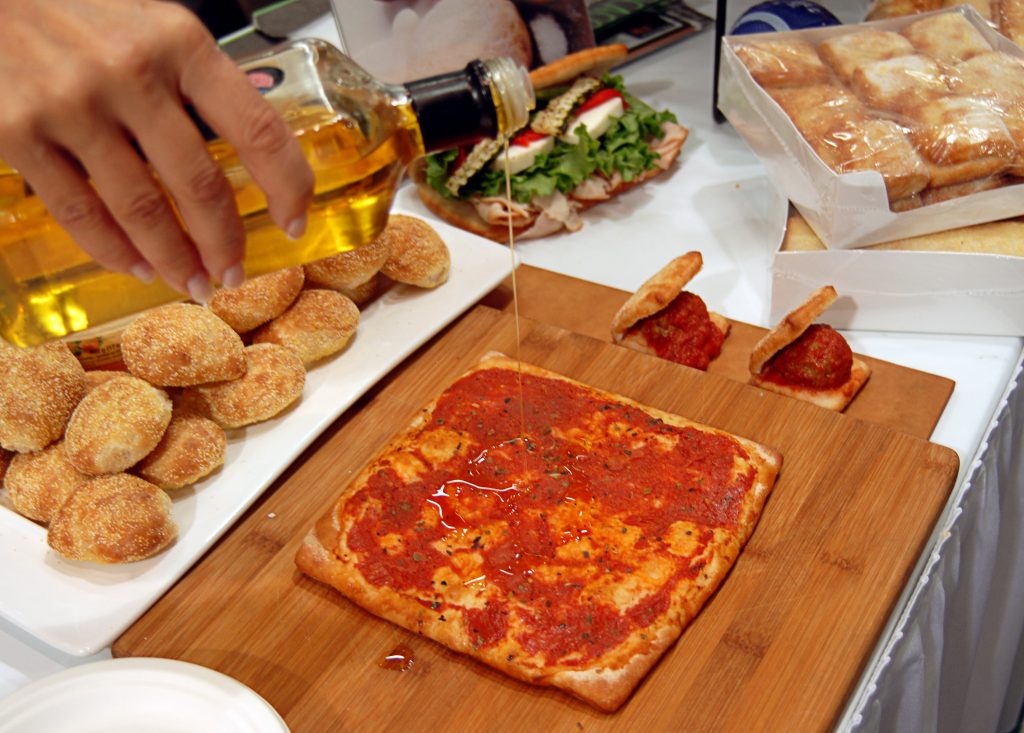Olive oil has always been known in the pizza industry as a fundamental ingredient in dough production, yet its exact role is still somewhat unknown to most people. Olive oil is frequently used to mix in salad dressings, dipping breads or simply to finish pizzas. When it comes to its impact on the finished pizza crust, olive oil plays an important role in determining texture and flavour as we will see in this article.
Olive oil defined
To begin with, we will define oil as fat in liquid form that can be derived from a multitude of sources such as: olives, peanuts, sunflower, etc. One of the most frequently asked questions in the industry is what is the difference between extra virgin olive oil and regular olive oil. In short, extra-virgin olive oil is the first press, made from pure, cold-pressed olives[1] and has a lower acidic level. It retains more of the nutritional benefits found in olives[2]. On the other hand, regular olive oil contains a blend of cold-pressed and processed oils. It is more acidic and it doesn’t have the peppery finish of its extra virgin counterpart. Regular olive oil is suitable for frying and greasing pans, whereas extra virgin olive oil can be used to drizzle over finished pizzas for an extra layer of richness.
A richer flavour
Based on its source, one of the main roles of oil in dough production is adding a distinctive flavour. In this case, using olive oil will add a subtle hint of olive flavour to the finished product. Depending on your pizza crust requirements, oil can be used to tailor the recipe to your specific needs, in order to achieve a unique product.
Generally speaking, any type of oil will add another layer of richness to the pizza crust. However, that is not to say that pizzas can’t be just as delicious without the use of oil. Take as an example the classic Neapolitan style pizza. This traditional Italian pie gets its unmistakable softness and elasticity from the use of water and lack of oil in dough production.
Maintaining a soft crust
In addition to its role as a flavour enhancer, oil is also an excellent ingredient used to create a softer, more tender crust. This is especially important in take-out or delivery businesses. Unlike the case of Neapolitan style pizza where the crust is baked in a wood burning oven and served and eaten right away, pizzas that are baked in conventional ovens and served later tend to lose some of their softness and elasticity as they get colder. In this case, the use of oil is essential as it helps to keep the crust softer for a longer time after baking, avoiding an unpleasant chewy or tough consistency.
Health benefits
As defined earlier, any oil is a liquid form of fat. All things considered, fats or oils have a bad reputation for being unhealthy, but that is not necessarily true. Considering the small amounts of oil used in dough production, a more practical way for consumers to cut down on fats is by substituting the amounts of meats and cheeses used to top the pizza. In this article, we talk about how to successfully introduce healthy pizza to your menu.
In addition to adding great flavour and enhancing texture, olive oil comes with an amazing array of health benefits such as: lowering the risk of heart disease, maintenance of healthy cholesterol levels, improved skin health, and many more.
At Mimi Foods, we use varieties of oils in some doughs, and we use extra virgin olive oil to create the most authentic, artisan-style dough products. Our skilled Research and Development department will work with you to create the perfect customized product for your business. To start your custom crust project, contact us today at artisticdough@mimifoods.ca or 905-660-0010.
[1]https://www.tastingtable.com/cook/national/extra-virgin-olive-oil-vs-olive-oil
[2]https://www.thekitchn.com/whats-the-difference-between-olive-oil-and-extra-virgin-olive-oil-word-of-mouth-218767


0 Comments